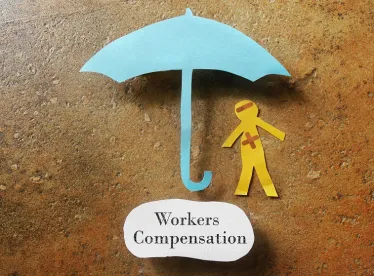On September 19, 2017, the Illinois Appellate Court, Workers’ Compensation Commission Division, issued an opinion in Dukich v. Illinois Workers’ Compensation Comm’n, 2017 IL App (2d) 160351WC, affirming the Commission’s decision to deny benefits in a case involving an employee’s fall on wet pavement at the employer’s premises while walking to her car en route to lunch. The appellate court applied a neutral risk analysis to conclude that the risk of walking on wet pavement, absent some defect in the employer’s premises or some evidence of increased qualitative or quantitative risk associated with the employment, was not a risk faced by the claimant to a greater degree than members of the general public. Presiding Justice William Holdridge authored the court’s unanimous opinion.
Short Facts
The claimant worked as an attendance clerk for Fenton Community High School and was injured when she fell as she was walking from the school building where she worked to her car, which was parked in a designated parking space in a parking lot controlled by her employer. The claimant had exited her building and began walking toward her car. As she walked down a handicap ramp between the building’s entrance and the street level, she lost her footing on the wet ramp and fell face first, injuring her head and nose. When asked at arbitration what caused her to fall, she answered, “[t]he rain. The water.” Dukich, 2017 IL App (2d) 160351WC, ¶ 8.
The Commission concluded there were no defects on the paved surface where the claimant fell – no holes, depressions, uneven surfaces, loose gravel, or puddles of rainwater. It also concluded that the area where the fall occurred was free of any snow or ice and that the surface was “merely wet from the rain.” Id. ¶ 35. According to the Commission’s findings of fact, there was no evidence that the employer had required the claimant to walk in the particular area where she fell and no evidence that the employer otherwise controlled the route taken by the claimant to her car.
Moreover, there was no evidence that there was any aspect of the claimant’s employment that enhanced the risk of walking over the wet pavement. As the appellate court explained:
For example, the claimant was not rushing to complete a work task at the time of her accident. Although she was carrying an umbrella and a purse at the time, the employer did not require her to carry those items.
Id.
Accordingly, the court found that “the risk that the claimant confronted at the time of her accident was the risk of walking on wet pavement in the rain on property owned and controlled by her employer.” Id. Thus, the question before the appellate court was “whether an injury caused by an exposure to that risk, standing alone, is compensable under the Act.” Id.
Appellate Court Analysis
The appellate court agreed with the Commission majority, finding that the “dangers created by rainfall are dangers to which all members of the public are exposed [to] on a regular basis.” Id. ¶ 36. These dangers, the court observed, “unlike defects or particular hazardous conditions located at a particular worksite, are not risks distinctly associated with one’s employment.” Id. As such, the court proceeded to analyze the claim under neutral risk principles – recovery may only be allowed “if the claimant can establish that she was exposed to the risks of injury from rainfall to a greater degree than the general public by virtue of her employment.” Id.
Applying this analysis to the facts of the case, the appellate court concluded that the claimant had failed to present any evidence of increased risk. While the court acknowledged the employer had provided the claimant a designated parking space in the parking lot, “there is no evidence that the employer exercised any control over the particular route the claimant took to her car or required the claimant to traverse the particular handicap ramp on which she was injured.” Id. Additionally, there was no evidence presented suggesting that the claimant’s work duties “somehow contributed to her fall or enhanced the risk of slipping on wet pavement,” and no evidence she was carrying any work-related items or hurrying to complete a work-related task when she slipped and fell. Id.
The appellate court further mentioned that even assuming the claimant was required to traverse the same path multiple times per day to get to her car, “she still could not recover benefits because there is no evidence that the wet pavement she encountered on that path was any different or more dangerous than any other wet pavement regularly encountered by members of the general public while walking in the rain.” Id. ¶ 37. In reaching its conclusion, the court pointed to the Illinois Supreme Court’s decision in Caterpillar Tractor Co. v. Industrial Comm’n, 129 Ill. 2d 52, 59 (1989), the claimant had twisted his ankle while stepping off a curb as he was walking from his workplace to the employee parking lot on the employer’s premises. The Dukich court noted that in Caterpillar, the Court acknowledged that the claimant had regularly crossed the curb on which he had fallen to reach his car, but nevertheless denied benefits because “’[c]urbs, and the risks inherent in traversing them, confront all members of the public’ and there was ’nothing in the record to distinguish [the curb upon which the claimant was injured] from any other curb.’” Dukich, 2017 IL App (2d) 160351WC, ¶ 37. (quoting Caterpillar, 129 Ill. 2d at 62-63). The Dukich court noted that the wet pavement upon which the claimant fell “was no different from any other wet pavement.” Dukich, 2017 IL App (2d) 160351 WC, ¶ 38.
Additionally, the appellate court noted that its conclusion that the claim was not compensable was not altered by the fact that the handicap ramp on which the claimant fell was sloped. “[T]he claimant presented no evidence suggesting that the paved handicap ramp upon which she fell was somehow different from or more hazardous than any other wet handicap ramp that members of the general public traverse every day.” Id.
Finally, the appellate court rejected the claimant’s suggestion that the wet pavement alone was a hazardous condition on the employer’s premises. Noting the case law holding that an accidental injury sustained on property that is either owned or controlled by an employer within a reasonable time before or after work is generally considered to “arise out of” and “in the course of” the employment, the court found those cases distinguishable because the condition of wet pavement, without a defect on the premises, is not a hazardous condition. Moreover, each of the cases cited by the claimant involved accumulations of ice or snow, or wet surfaces within the employer’s building, none of which were present here. The claimant’s fall occurred outside on wet pavement.
Implications
The appellate court’s decision makes it clear that when analyzing the risks posed by exposure to the elements or “acts of God,” it will apply neutral risk principles. In such cases, “[t]he employee’s injuries … are compensable only if the claimant shows that he was exposed to some increased risk by virtue of his employment.” Id. ¶ 42. As with all cases considering increased risk, the court will consider the quantitative (how frequently encountered) and qualitative (how physically encountered) nature of the risk as it relates to the employment.
Dukich is a good case for employers when dealing with premises-related accidents caused by exposure to the elements. Moreover, it provides an excellent overview of what factors the Commission should consider when evaluating such claims.




 />i
/>i
